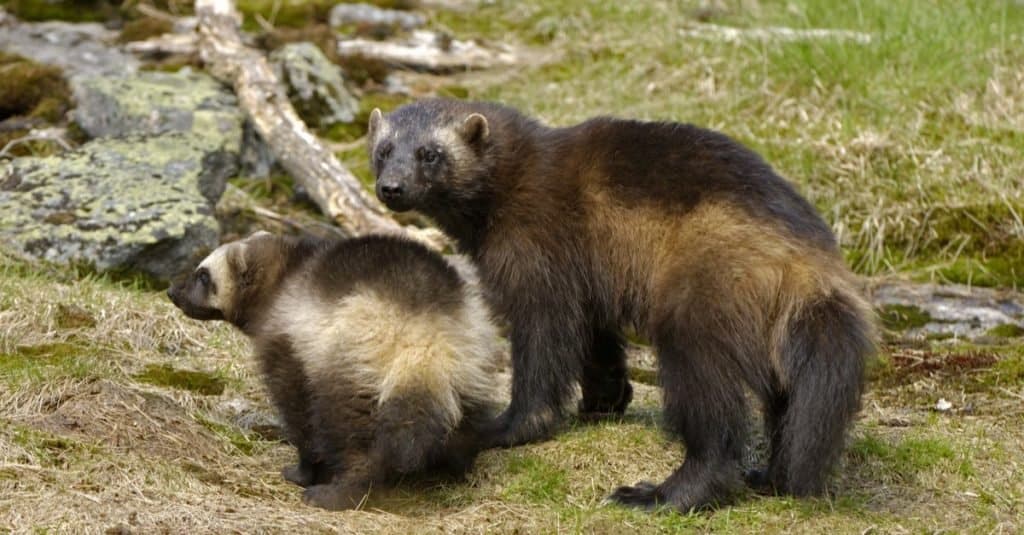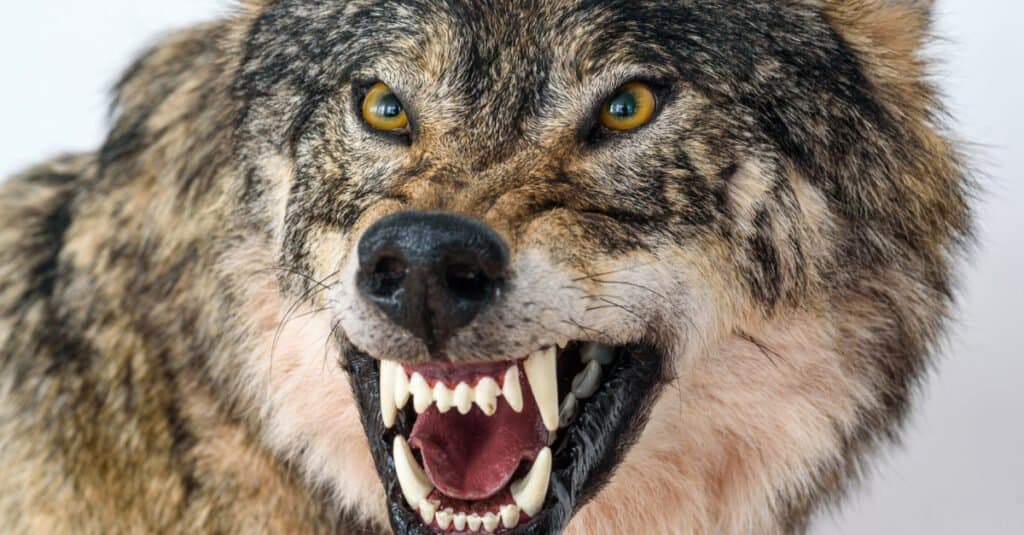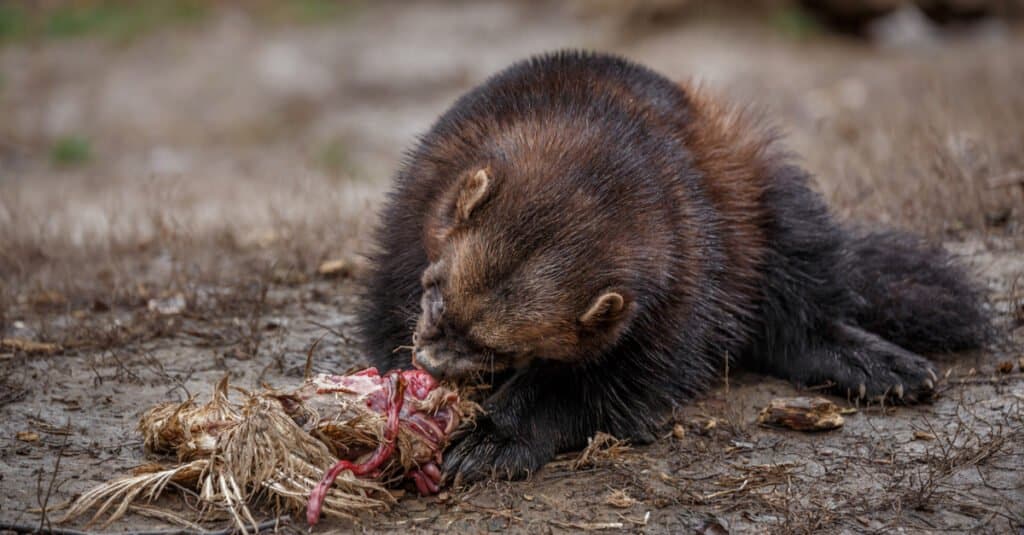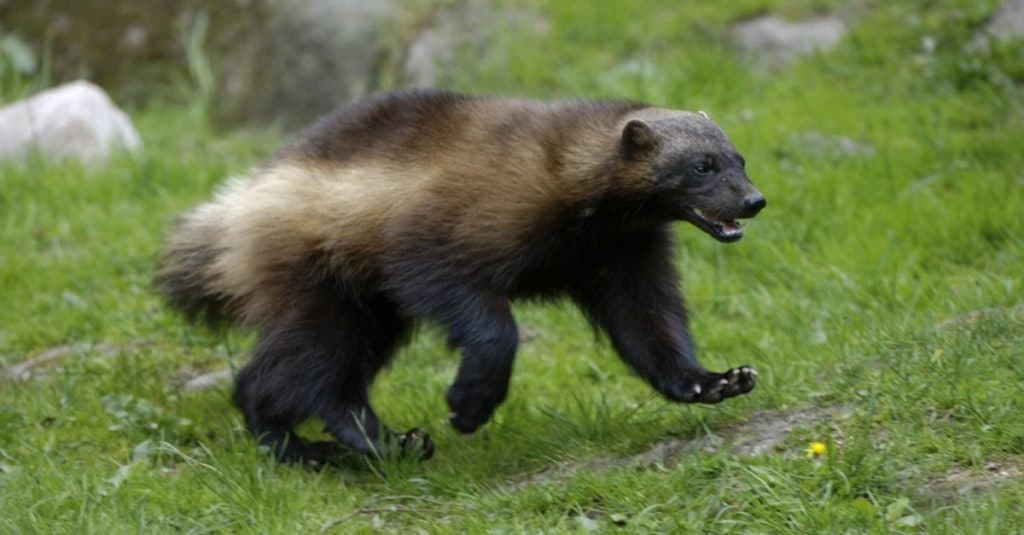Wolverines are some of the most ferocious animals on earth. They roam North America and Russia, thriving in cold climates and killing animals much larger than themselves. Another mammal that lives in the same areas is the wolf. These large canines live in packs and regularly hunt down big animals for food. So, what happens in a wolverine vs wolf fight? Can the hyper-aggressive wolverine take down an apex predator? We’ll show you what would happen in a battle.
Comparing a Wolverine and a Wolf

| Wolverine | Wolf | |
| Size | Weight: 22lbs – 70lbs Length: 2.1ft – 3.5ft | Weight: 80-150lbs Length: 3.4ft – 5ft Height: 26in – 36in |
| Speed and Movement Type | – 30 mph – Uses a fast gallop to run | – 35mph in short bursts – Uses a galloping sprint |
| Bite Power and Teeth | – 50 PSI bite power – Special molars designed to break bones and tear meat | 400 PSI bite power, perhaps more in the wild. – 42 sharp teeth – 2-inch-long canines |
| Senses | – Poor eyesight – Great hearing – Great sense of smell capable of smelling prey in burrows from above ground. | – Powerful sense of smell – Keen sense of vision with front -facing eyes like many predators. – Wolves can hear creatures from miles away. |
| Defenses | – Thick fur – Smelly musk that can drive off some predators | – Safety in numbers in its pack – Speed to run away from danger |
| Offensive Capabilities | -Uses strong teeth and jaws to attack and kill -Claws for digging and climbing can be used to cut prey | – Powerful bite with 2-inch teeth – Sharp claws can lead to slashing attacks – Has limited climbing abilities |
| Predatory Behavior | -Pounces from stealth -Runs down slower enemies -Solo hunter -Scavenger | – Endurance predators that chase down and tire out enemies with consistent speed and sapping attacks |
The Key Factors in a Fight Between a Wolverine and a Wolf

This fight would be decided by size, weight, and ability to fight.
©Bildagentur Zoonar GmbH/Shutterstock.com
Not every facet of the two animals is necessary to explore to determine which of these animals would win in a fight against each other. Instead, we’re going to focus on the physical features of the wolf and wolverine along with the way they combat their foes. Using this approach, we’ll see which animal has what it takes to walk away from a one-on-one battle.
Physical Features of a Wolverine and a Wolf

Wolves can grow up to 3ft tall and 5ft long.
©shymar27/Shutterstock.com
The best way to compare the animals and get an idea of which has the most advantages over the other is to look at their physical characteristics. We’re going to compare five different facets of these animals and get a better idea of how they measure up to one another.
Wolverine vs Wolf: Size
Although it may be tempting to write off the wolverine right away, they can be quite sizable creatures. Their largest wolverines can weigh 70lbs and grow up to 3.5ft in length. That’s small compared to a wolf, though. They weigh upwards of 150lbs and grow 5ft long and stand over 3ft high. The largest wolf is the Mackenzie Valley wolf, which lives in Northern Canada and Alaska.
Wolves are the larger animal, and they have a size advantage.
Wolverine vs Wolf: Speed and Movement
A wolverine can run at 30mph using a galloping motion. Interestingly, they have incredible endurance, and they can run for dozens of miles without stopping, albeit not at top speed. Wolves are slightly quicker, running up to 35mph in short bursts.
Wolves are faster, so they get the advantage.
Wolverine vs Wolf: Bite Power and Teeth
Wolverines cause most creatures to back off after a bite because they leverage a low bite power into a devastating attack due to their teeth. When they bite down with 50 PSI, less than a dog, they can still break bones and tear flesh away with ease.
Wolves have teeth similar to dogs. Their canines are 2-inches long and they can bite with 400 PSI of biting power. Their teeth help them tear away flesh and puncture vital areas.
Wolves have the advantage in terms of biting.
Wolverine vs Wolf: Senses
Wolverines have bad sight, but they make up for that with great hearing and a sense of smell that lets them locate prey that is hiding in burrows underground. Wolves have great hearing, smell, and vision, so they’re perfect for hunting down their prey.
Wolves have better senses than wolverines.
Wolverine vs Wolf: Physical Defenses
Wolves’ defenses are not that profound. In fact, much of their benefits stem from their speed and their pack mentality. Wolverines’ physical defenses include their thick fur and a rancid musk they can excrete to drive off or gag some predators.
Combat Skills of a Wolverine and a Wolf

Wolverines use their teeth and claws to kill their foes.
©Josef_Svoboda/Shutterstock.com
Wolves are rather simple creatures when it comes to fighting. As pack animals, they will find prey and attack it through endurance predation. That means they chase an animal and bite at it until it’s completely exhausted, and then they move in for the kill.
Wolverines are much more direct. They will use both their claws and teeth to savagely attack their prey once they surprise their prey from stealth. They are only solo hunters, too.
In a single combat situation, wolverines are far more skilled.
What Are Key Differences Between a Wolverine and a Wolf?

Wolves are pack animals and wolverines live alone.
©Holly S Cannon/Shutterstock.com
The wolf belongs is called a Canis lupus, and they are the creatures from which domesticated dogs evolved. Wolves are taller, longer, and heavier than wolverines. Wolves are also faster than wolverines, too.
Wolverines are a member of the weasel family, and they live in the northern parts of North America and Russia. Wolves also inhabit these areas, but they also live in Central America, parts of Africa, and Europe. Wolverines live solo, and wolves live in packs. These major differences set the animals apart from each other.
Who Would Win in a Fight Between a Wolverine and a Wolf?

Surprisingly, a wolverine has a better chance of winning a fight against a wolf.
©Bildagentur Zoonar GmbH/Shutterstock.com
A wolverine would win a fight against a wolf. Although the size disparity and bite power make the wolf seem like the obvious winner, a problem emerges when we consider that the wolf hunts in packs. Without its pack, a wolf’s strategy has to change.
Wolverines are used to fighting alone, and they’re great at ambushing larger animals. When the fight starts, the wolverine will relentlessly attack the wolf using its claws, agility, and powerful bites. None of these are going to kill the wolf outright, though.
Yet, if the wolverine manages to use its musk to stymie the wolf, it can do some serious damage. Either one of these creatures killing the other alone will be a tall order. However, the wolverine can inflict damage to the wolf while dodging counterattacks. In a battle of stamina, the wolverine wins.
For all these reasons, a solo wolverine would likely kill a solo wolf. However, it’s far more likely that the wolf would retreat before it received fatal damage.
What Animal Can Defeat a Wolverine?
While there are not many examples of more tenacious and ferocious beasts in the animal kingdom, the wolverine is only so big. There are many animals that have more strength, reach, and power that could overwhelm a wolverine. We are not saying that many animals would want to fight one or that they would come away from such a fight unscathed!
A grizzly bear is just one of those examples of animals that could take down a wolverine, and they realistically could come across one another’s path and fight for food or territory. The wolverine has few advantages in such a fight other than its fortitude and inability to back down. They surely would make the fight unpleasant for the bear, but a grizzly could swiftly reduce a wolverine to a pulp if it landed a powerful swipe. A grizzly’s bone crushing bite would also make short work of a wolverine and not only cause internal bleeding but also pierce major organs of the weasel.
The photo featured at the top of this post is © iStock.com/ErikMandre
Thank you for reading! Have some feedback for us? Contact the AZ Animals editorial team.







